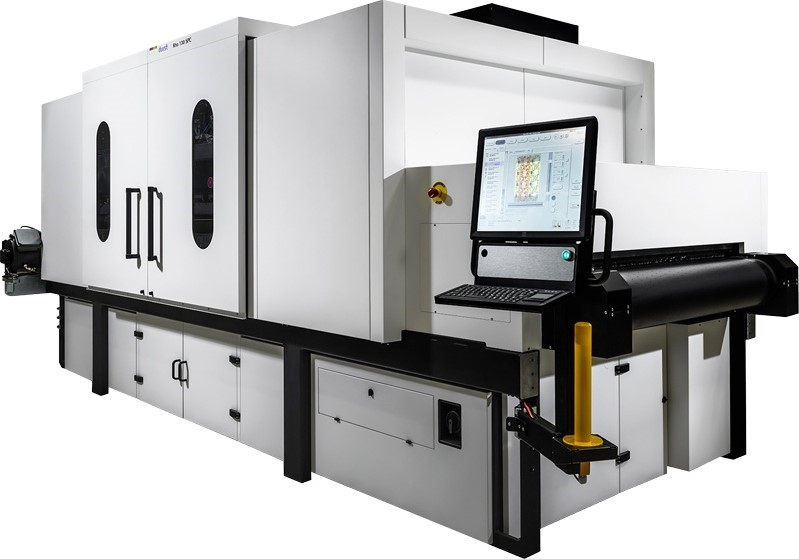History Of Printing
The history of printing
Printing (graphic communication by multiplied impressions) has a long history behind it. This page describes its evolution. It acts as a summary of a more elaborate description that starts here. You can also click on the title of each century to get more in-depth information. There is a separate section on the history of prepress.
3000 BC and earlier
The Mesopotamians use round cylinder seals for rolling an impress of images onto clay tablets. In other early societies in China and Egypt, small stamps are used to print on cloth
Second century AD
A Chinese eunuch court official named Ts’ai Lun (or Cai Lun) is credited with inventing paper.
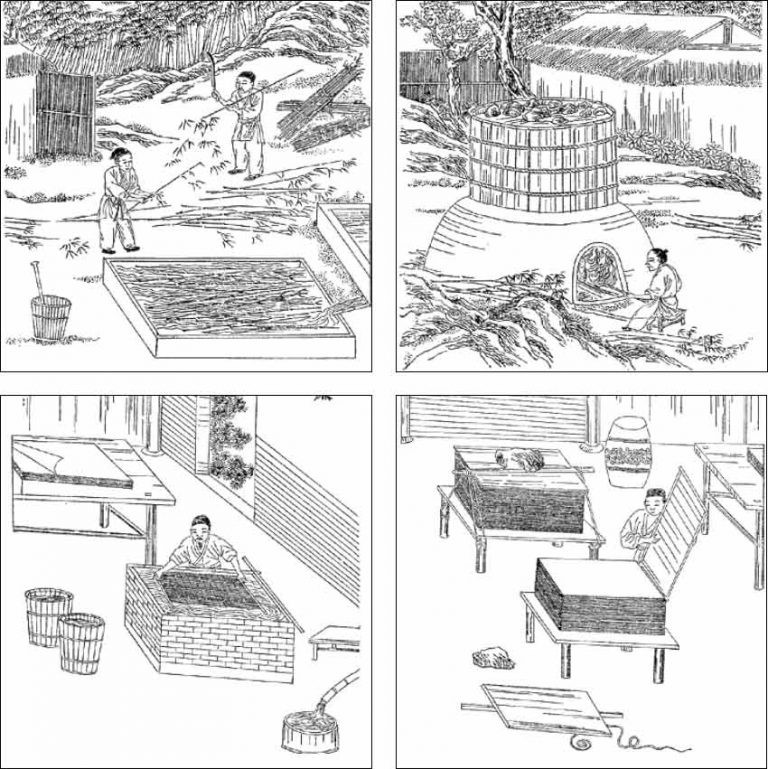
Eleventh century
A Chinese man named Pi-Sheng develops type characters from hardened clay, creating the first movable type. The fairly soft material hampers the success of this technology.
Twelfth century
Papermaking reaches Europe.
Thirteenth century
Type characters cast from metal (bronze) are developed in China, Japan and Korea. The oldest known book printed using metal type dates back to the year 1377. It is a Korean Buddhist document, called Selected Teachings of Buddhist Sages and Seon Masters.
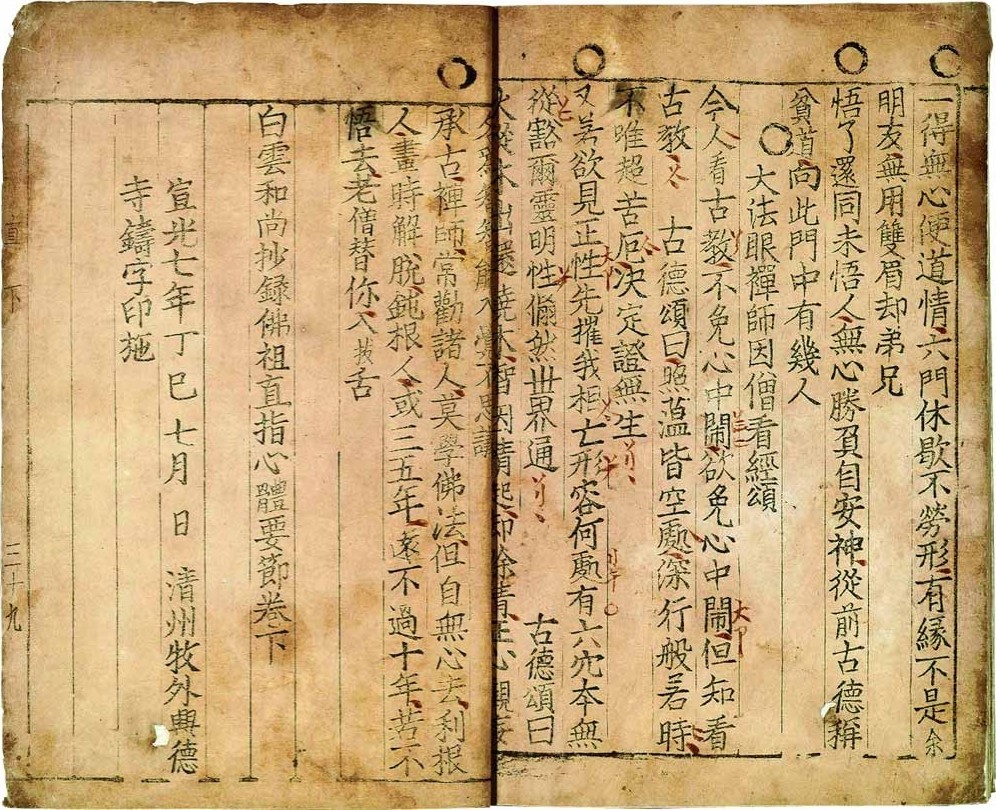
Fifteenth century
Even though woodcut had already been in use for centuries in China and Japan, the oldest known European specimen dates from the beginning Of the 15th century. Woodcut is a relief printing technique in which text and images are carved into the surface Of a block Of wood. The printing parts remain level with the surface while the non-printing parts are removed, typical y with a knife or chisel. The woodblock is then inked and the substrate pressed against the woodblock. The ink that is used is made of lampblack (soot from oil lamps) mixed with varnish or boiled linseed oil
Books are still rare since they need to be laborious y handwritten by scribes. The University Of Cambridge has one Of the largest libraries in Europe — constituting just 122 books
In 1436 Gutenberg begins work on a printing press. It takes him 4 years to finish his wooden press which uses movable metal type. Among his first publications that get printed on the new device are bibles. The first edition has 40 lines per page. A later 42-line version comes in two volumes.

In 1465 the first drypoint engravings are created by the Housebook Master, a south German artist. Drypoint is a technique in which an image is incised into a (copper) plate with a hardpointed ‘needle’ of sharp metal or a diamond point.
In their print shop in Venice John and Wendelin of Speier are probably the first printers to use pure roman type, which no longer looks like the handwritten characters that other printers have been trying to imitate until then.
In 1476 William Caxton buys equipment from the Netherlands and establishes the first printing press in England at Westminster. The painting below depicts Caxton showing his printing press to King Edward IV.
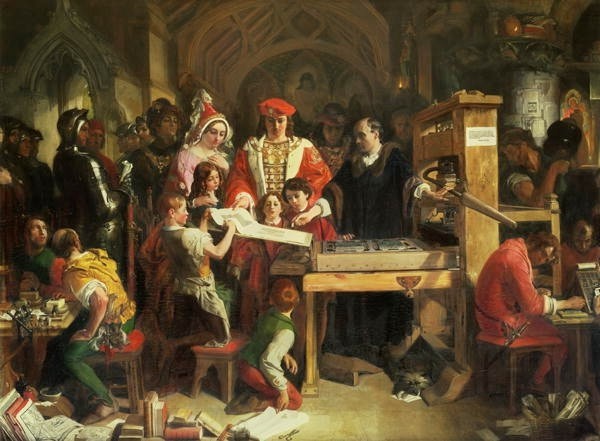
That same year copper engravings are for the first time used for illustrations. With engravings, a drawing is made on a copper plate by cutting grooves into it.
By the end of the century, printing has become established in more than 250 cities around Europe. One of the main challenges of the industry is distribution, which leads to the establishment of numerous book fairs. The most important one is the Frankfurt Book Fair.
Sixteenth century
Aldus Manutius is the first printer to come up with smaller, more portable books. He is also the first to use Italic type, designed by Venetian punchcutter Francesco Griffo.
In 1507 Lucas Cranach invents the chiaroscuro woodcut, a technique in which drawings are reproduced using two or more blocks printed in different colors. The Italian Ugo da Carpi is one of the printers to use such woodcuts, for example in Diogenes, the work shown below.
The history of print from 1400 to 1499
This page documents the evolution of printing and publishing during the fifteenth century. The main event from this era is Gutenberg’s invention of a printing press that works with movable type. It revolutionizes the production of books and pamphlets. By the end of the century printing presses can be found in more than 250 cities around Europe. Such presses can produce 3,600 pages per workday, compared to forty by typographic hand-printing and just a few pages by hand-copying. The books printed between the 1450s and the end of the fifteenth century are called ‘incunabula’. One of the main challenges of the industry is distributing all these works. This leads to the establishment of numerous book fairs. The most important one is the Frankfurt Book Fair which is first held by local booksellers soon after Gutenberg’s invention of the printing press.
1423 — First woodcut printing on paper
Even though woodcut is already used for printing on cloth for over a century, the first European woodcut printing on paper happens in the early 15th century. It is used for printing religious images and playing cards. Woodcut is a relief printing technique in which text and images are carved into the surface of a block of wood. The printing parts remain level with the surface while the non-printing parts are removed, typically with a knife or chisel. The woodblock is then inked and the substrate pressed against the woodblock. The ink is made of lampblack (soot from oil lamps) mixed with varnish or boiled linseed oil. This printing technique is also called block printing. One of the earliest examples of European woodcuts is the image of Saint Christopher shown below. It was printed in 1423 and then manually colored in.
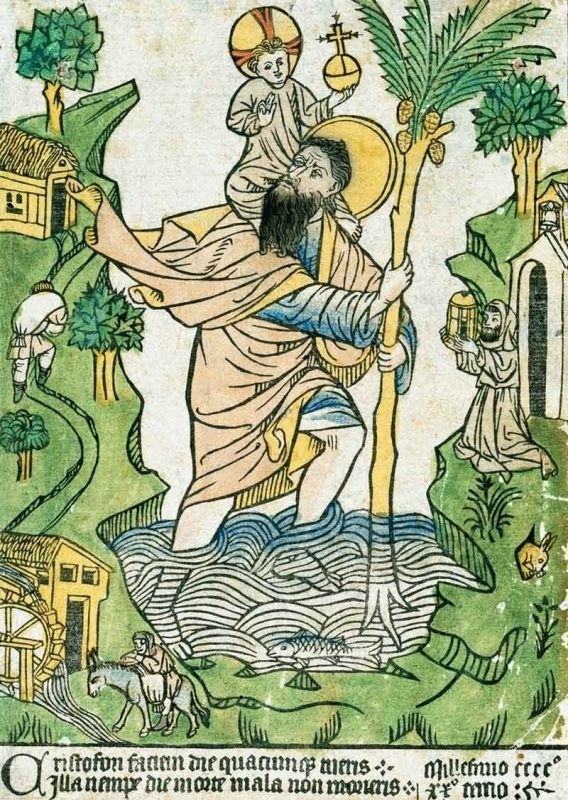
The first complete block books or xylographica are produced in Germany and Holland around 1430. They continue to be produced until around 1480.
1424
Books are still rare since they need to be laboriously handwritten by scribes. The University of Cambridge has one of the largest libraries in Europe — constituting just 122 books.
The parchment that books are written on is so expensive that books that are no longer relevant are not thrown away. The old text is scraped off and replaced by a new one. These reused books are called palimpsests. Using UV light historians can often still read the original text, making these books an important source for ancient texts.
1436 — Gutenberg starts working on a printing press
It takes Johannes Gutenberg, the German goldsmith, inventor, printer, and publisher, four years to finish his wooden press which uses movable metal type. The image below shows a replica of a press from that era. It uses relief printing: at the bottom left a frame holds the columns of text that get printed. This type consists of individual letters set in lead. After inking the type, a sheet of paper is put on top. Next, the frame is shoved to the right underneath the platen. By moving the large handle pressure is applied to make sure the ink is transferred to the paper. Afterward, the bed is moved back to its original position and the paper can be removed.

The press itself is based on the wine presses that were already in use for centuries in that region. Relief printing, through woodblock printing, also isn’t new. Movable type had already been used in the East. What Gutenberg does is bring these various technologies, including the proper type of oil-based ink, together. His real innovation is the molding system that enables a printer to create as many lead characters as are needed for printing a book or pamphlet.
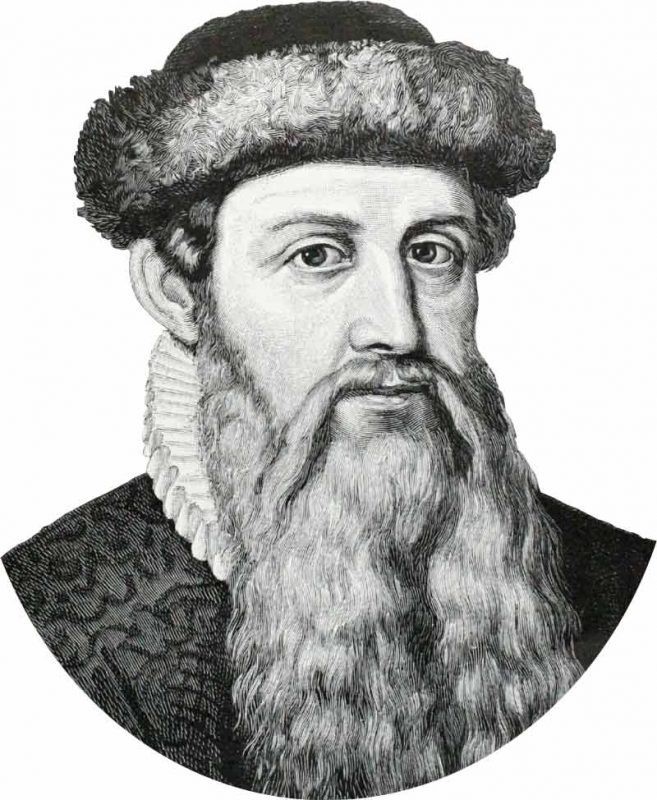
1448 — Gutenberg sets up a printing shop in Mainz
Among his first publications printed using movable type are the ‘Poem of the Last Judgment’ and the ‘Calendar for 1448’. Around 1450 Gutenberg begins printing bibles, initially using 40 lines of text in each of the two columns but later switching to 42 lines to reduce page count.
1453
Constantinople is captured by the Turks. Many books from its Imperial Library are burned or carried away and sold. This marks the end of the last of the great libraries of the ancient world.
1455 — Gutenberg Bible
Gutenberg finishes printing between 160 and 185 copies Of his 42-line bible which is referred to as the Gutenberg Bible. It is considered the first mass-produced book. The text is set using a gothic type that mimics handwriting. Customers can have their copy decorated manually. A quarter of the books are printed on vellum, the others use paper.
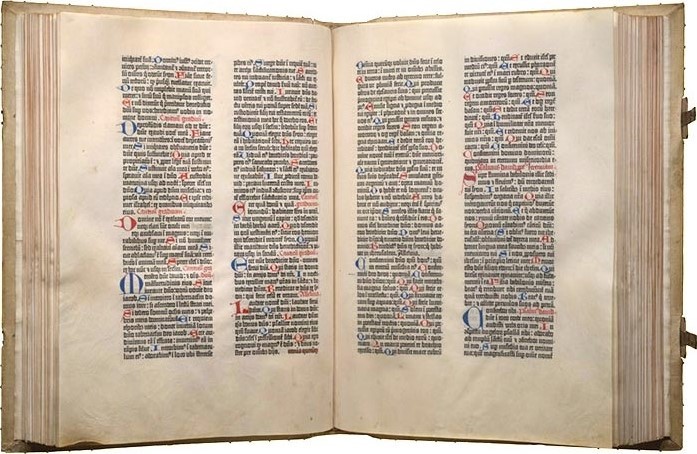
Ironically enough Gutenberg goes bankrupt in 1455 when his investor Johann Faust forecloses on the mortgage used to finance the building of the press. Faust gets hold of the printing equipment as well as the copies of the bible that have already been printed. While trying to sell them in Paris Faust tries to keep the printing process a secret and pretends the bibles are hand copied. It is noticed that the volumes resemble each other and Faust is charged with witchcraft. He has to confess his scheme to avoid prosecution.
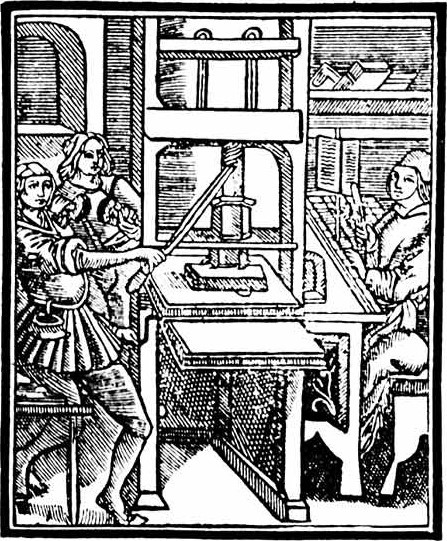
1457 — First color printing
The first known color printing is used in ‘Mainz Psalter’, a book containing a collection of psalms. It is printed by Johann Faust and his son-in-law Peter Schöffer. Color, in this case, does not mean full-color images but simply the use of additionals color to highlight some initials, words, or paragraphs. In the Psalter black, red and blue ink is used. It is also one of the first books to contain a colophon, a page, or part of a page that describes who printed the book, the location of the printer, and its production date.
1460 — Catholicon
The first printed edition of The Summa grammaticalis quae vocatur Catholicon, or Catholicon, appears. This Latin dictionary dates back to the 13th century. The printed edition uses a typeface that is a third smaller than that of Gutenberg’s 42-line Bible, lowering its production cost significantly. t is most likely the last book printed by Gutenberg himself, who dies in 1468.
1461 — First books with woodcut illustrations
Albrecht Pfister prints the first illustrated books using a number of woodcuts that are colored in manually. The example below is from a book of fables called Der Edelstein. Another of his books, the Biblia Pauperum, also contains many hand-colored illustrations. Pfister is also one of the first to print books in the German language.
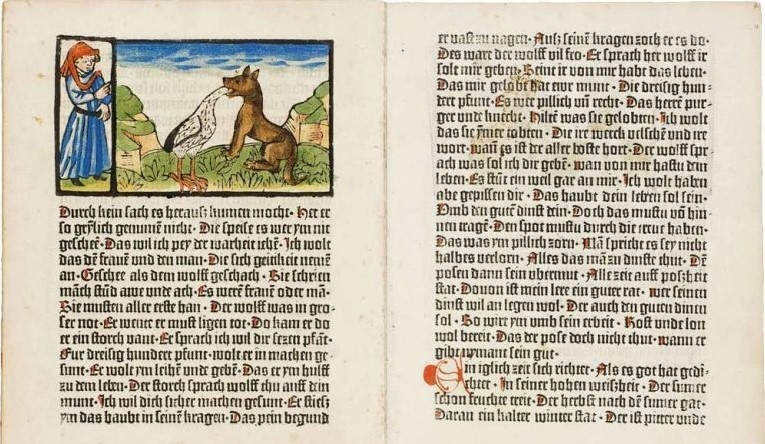
1464 — Printing arrives in Italy
German monks operate the first printing press in Italy in the Abbey of Santa Scolastica at Subiaco. In 1467 Ulrich Haan (Udalricus Gallus) is the first one to print books in Rome. Haan had emigrated after his letterpress print shop in Vienna was destroyed because he had dared to print a lampoon against the mayor. The first book to be printed in the Italian language is Il Canzoniere by Francesco Petrarca in 1470.
1467 — First engravings
In Bruges, Colard Mansion prints De cas de nobles hommes et femmes (De Casibus Virorum Illustrium), the first book that is illustrated with engravings. An engraving is made by incising a metal plate with a tool called a burin. This plate is then warmed up so that the ink applied to it becomes fluid and also fills all those tiny holes and lines. Next, the ink on the flat surface is swiped off, so that only the nooks and crannies are still filled with it. A slightly moistened paper sheet is placed on the plate and sent through a rolling press. Its pressure makes sure the paper picks up the ink from the drawing. The process is more cumbersome and slower than woodcut printing but engravings are more robust than woodcuts so that more copies can be printed. Drawings can also be more detailed. Over time this technique will replace woodcuts. Colard also prints the first books in English and French.
Another famous engraver from that era is the Master of the Housebook, a south German artist whose ninety-one prints are extremely rare.
1469 — Use of roman type
In their print shop in Venice John and Wendelin of Speier are probably the first printers to use pure roman type, which no longer looks like the handwritten characters that other printers have been trying to imitate until then. Another printer in Venice, Nicolas Jenson, produces a more distinguished roman font which still serves as a model for type designers today.
Nicolas Jenson – roman type
The fact that most of the books printed between 1450 and 1480 are almost indistinguishable from handwritten manuscripts is down to the conservatism of their buyers. It takes a few decades before legibility is valued higher than convention.
1470 — Title pages & page numbers
Some things we now take for granted were not present in early books. Examples of these are a title page and page numbers. Peter Schoffër, an apprentice of Johannes Gutenberg, is the inventor of the title page while Arnold Therhoernen, a printer in Cologne, is one of the first to use both a title page and page numbers.
1472 — Book printing takes off in Spain
Sinodal de Aguilafuente is the first book printed in Spain and in the Spanish language. Its printing was ordered by the bishop of Segovia, which is why printing did not take off first in any of the major Spanish cities, like Barcelona or Madrid.
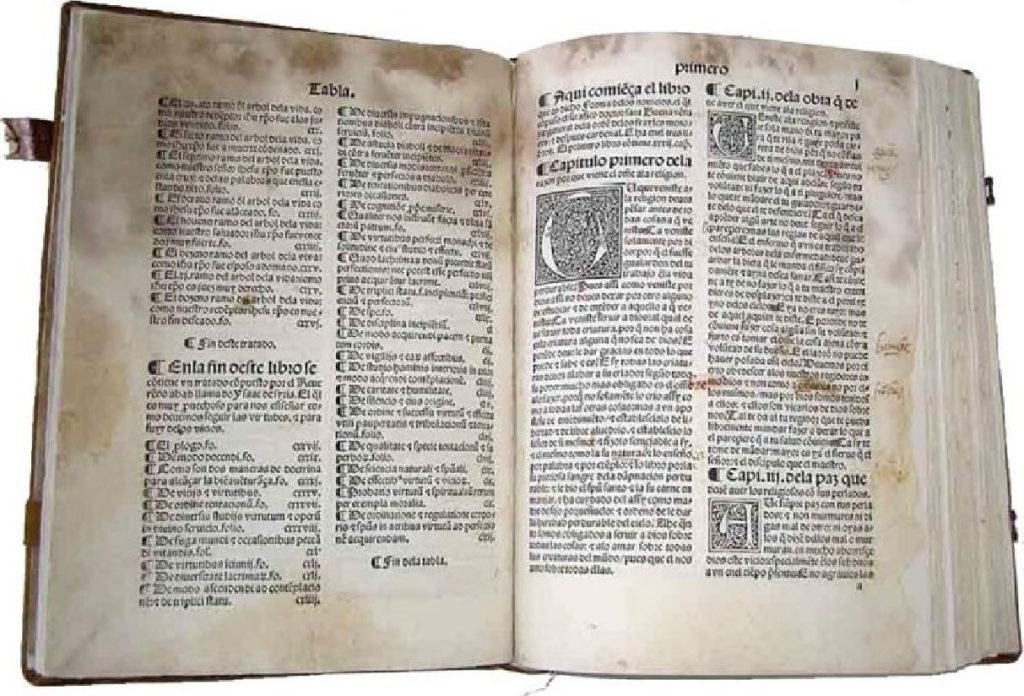
1475
‘De honesta voluptate’ (On honourable pleasure) is one of the first printed cookbooks. It is as much a series of moral essays as a cookbook. Ten years later ‘Kuchenmeysterey’ (Kitchen Mastery) becomes the first printed German cookbook.
1476 — William Caxton introduces metal type in England
William Caxton buys equipment from the Netherlands and establishes the first printing press in
England at Westminster. Books printed by Caxton include Chaucer’s ‘The Canterbury Tales’, ‘Fables of Aesop’ and many other popular works. Caxton is also the first English retailer of printed books. The painting below depicts Caxton showing his printing press to King Edward IV.
1470 — Title pages & page numbers
Some things we now take for granted were not present in early books. Examples of these are a title page and page numbers. Peter Schoffër, an apprentice of Johannes Gutenberg, is the inventor of the title page while Arnold Therhoernen, a printer in Cologne, is one of the first to use both a title page and page numbers.
1472 — Book printing takes off in Spain
Sinodal de Aguilafuente is the first book printed in Spain and in the Spanish language. Its printing was ordered by the bishop of Segovia, which is why printing did not take off first in any of the major Spanish cities, like Barcelona or Madrid.
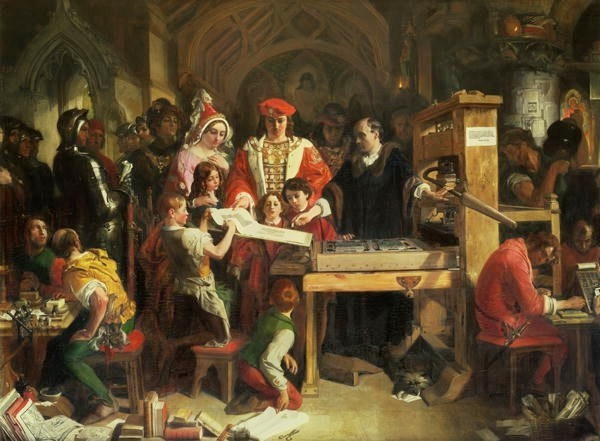
1481
There are around 40 printing shops in both Germany and Italy. In the Netherlands, printing takes place in 21 cities and towns. Some of the printing houses are large. in Nuremberg, the German printer Anton Koberger employs 100 people for punch-cutting, typesetting, operating 24 presses, and bookbinding. He owns two paper mills, has agents selling his works all over Western Europe and yet finds the time to father 25 children.
1482 — First print shop in Denmark
Johan Snell introduces printing in Odense. Dutch printer Gotfried van Os (Gotfred of Ghemen) establishes the first print shop in Copenhagen in 1493.
1492 — ‘In Praise of Scribes’
De laude scriptorum manualium is a book by the German Benedictine abbot Johannes Trithemius in which he criticizes the effect that the printing press has on the customs and devotion of the brotherhood of monks. Only by copying the Scriptures can a scribe become in touch with the Word of God. The abbot is a complex man who actually sees that printing also offers advantages. He expands the library of his abbey from around fifty items to more than two thousand, many of them printed. His own treatise also is printed since that is the most costeffective way to spread the message.
1493 — The Nuremberg Chronicle
Anton Koberger, a publisher and printer in Nuremberg, prints his most famous book, the
‘Nuremberg Chronicle’. It is illustrated with hundreds of woodcuts, many of them portraits. These portraits are all imaginary and the same block is often used to depict different persons.
1494 — Das Narrenschiff
Das Narrenschiff (The Ship Of Fools) by Sebastian Brant is published in Basel, Switzerland. This satire about the state of the church is illustrated with woodcuts from the great Renaissance artistengraver Albrecht Dürer. It quickly becomes extremely popular, with six authorized and seven pirated editions published before 1521.
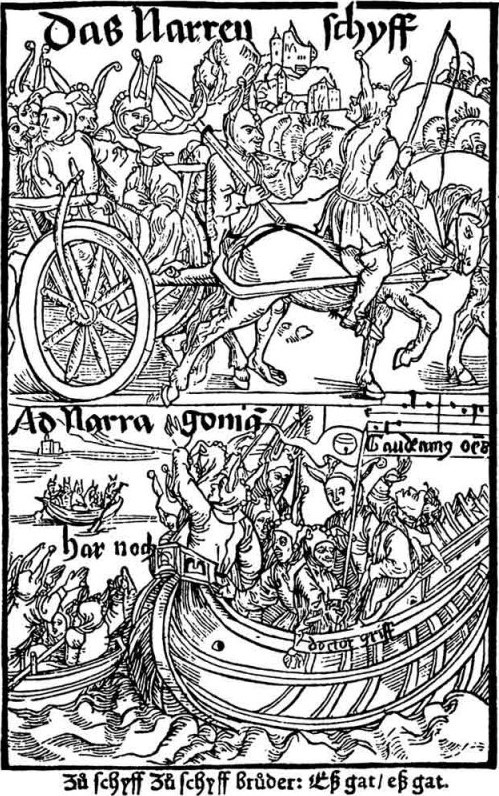
Dürer’s own ‘Apocalypse’ is another very popular book of that era, published simultaneously in Latin and German. Prints of the detailed woodcuts, such as The Four Horsemen of the Apocalypse shown below, are also sold separately.
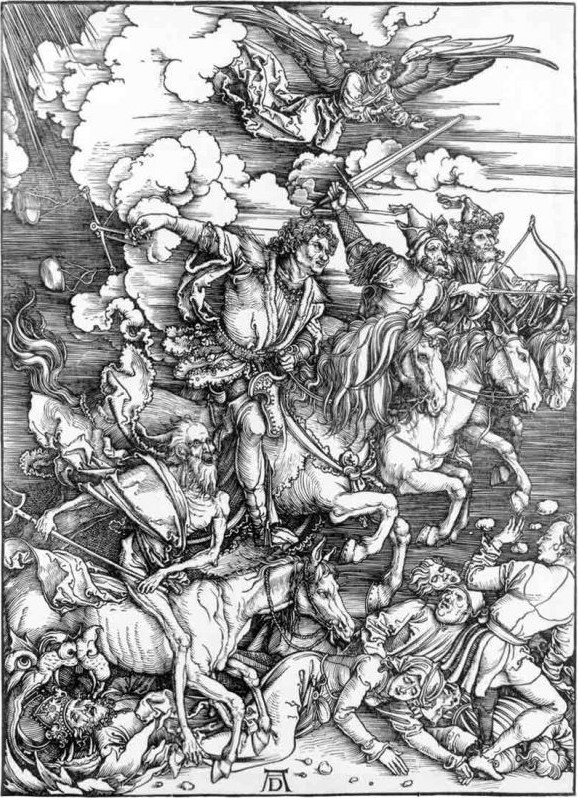
1495
The first printed books are published in Danish and Swedish. Earlier books used Latin. During the 15th century, around 75% of all printed matter is in Latin, 8% is in Italian and another 8% is in German. England and Spain are the only countries in which the majority of works are printed in the local language.
1499 — Aldus Manutius & Francesco Griffo
Aldus Manutius, who had helped found the Aldine Press in Venice in 1494, is the first printer to come up with smaller, more portable books. Until then books are large and heavy, meant to be read while standing at a lectern or reading stand. Manutius’s books are smaller and can be carried around and read anywhere. The book format is called an octavo (‘in eight’) because each press sheet is folded three times to create eight pages. For each edition up to 1000 copies are printed, instead of the customary 100 to 250. To cram as much text as possible on pages, Manutius is the first to use the more compact Italic type, designed by Venetian punchcutter Francesco Griffo. In 1499 the Aldine Press prints Hypnerotomachia Poliphili, an illustrated book set in Bembo. It is considered one of the masterpieces of Renaissance publishing. At the turn of the century, Venice is the center of the book industry in Italy, with around 150 presses in operation.
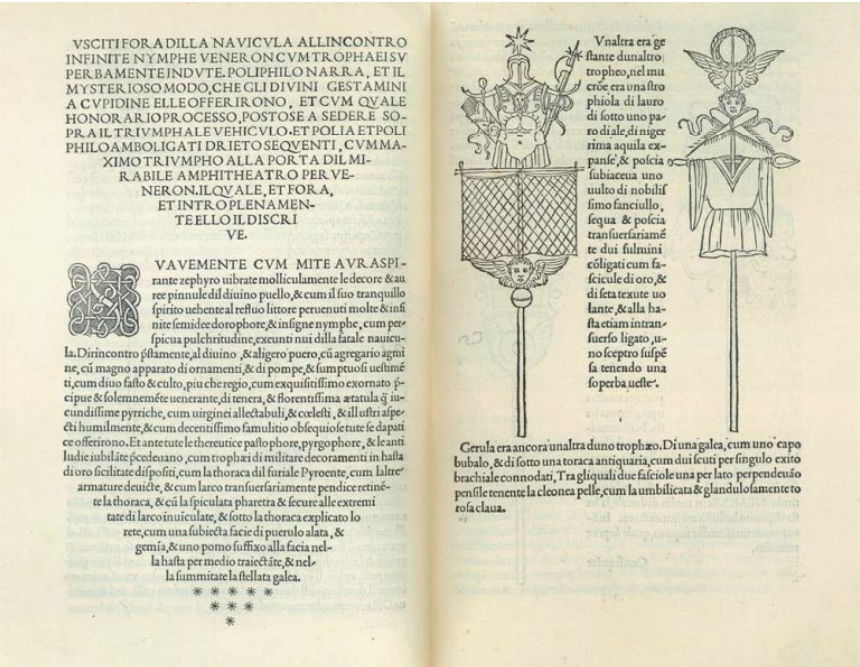
Also from 1499 is a version of Danse Macabre, a picture book about how nobody can escape death, with the first known depiction of a print shop. This book is printed by Mathias Huss in Lyon, France.
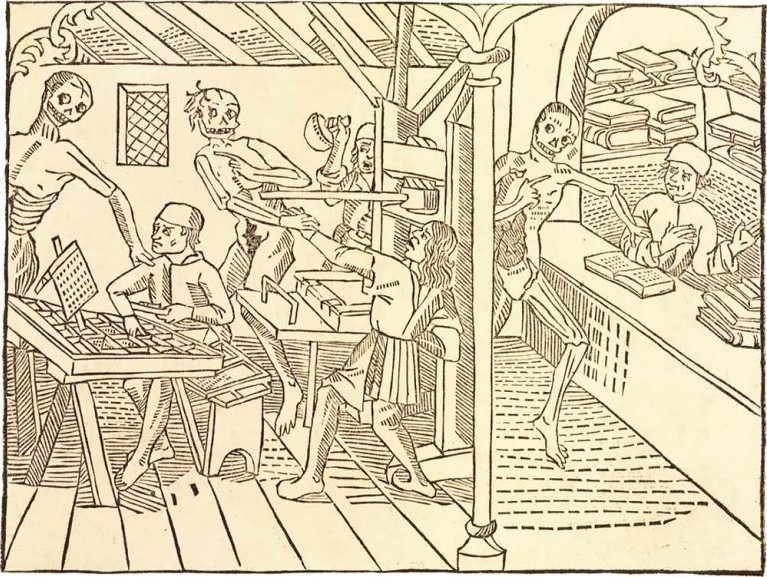
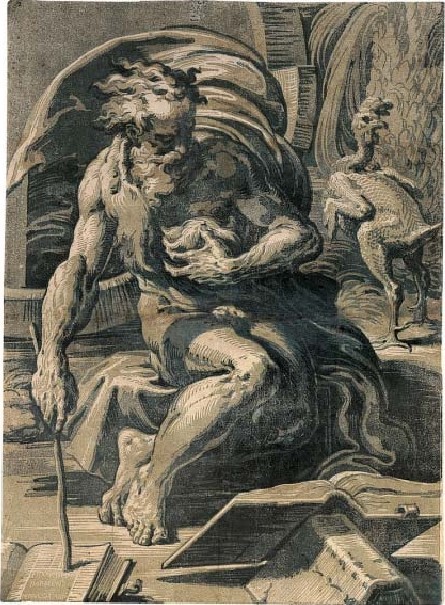
In 1525 the famous painter, wood carver and copper engraver Albrecht Durer publishes
‘Unterweysung der Messung’ (A Course on the Art ot Measurement), a book on the geometry of etters
The ‘Historia Veneta’ (1551) is one Of the many books Of Pietro Bembo, a Venetian scholar, and cardinal Who is most famous for his work on the Italian language and poetry. The Bembo typeface is named after him.
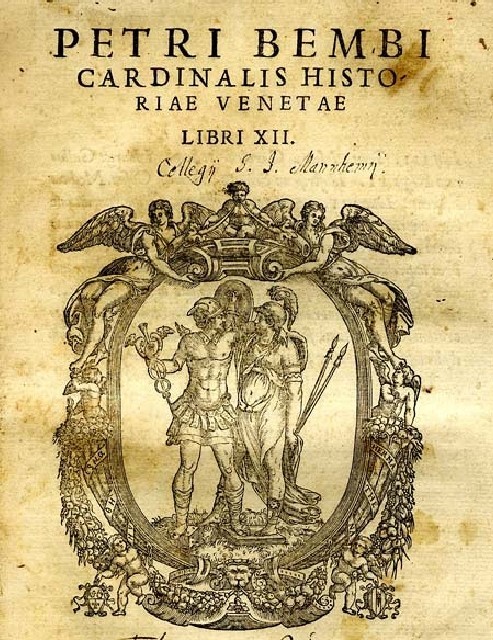
Christophe Plantin is One Of the most famous printers Of this century. In his print shop in Antwerp, he produces fine work ornamented with engravings after Rubens and other artists.
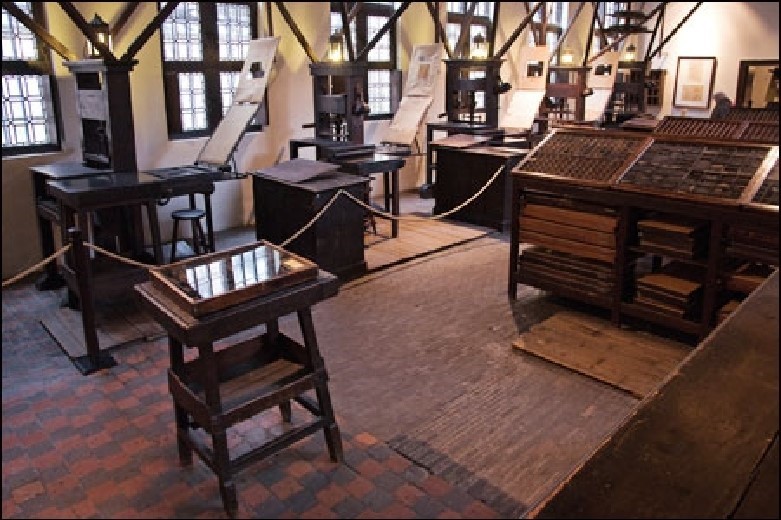
Many of his works as well as some of the equipment from the shop can be admired in the PlantirrMoretus Museum
Plantin is also the first to print a facsimile. A facsimile is a reproduction of an old book, manuscript, map, art print, or another item that is as true to the original source as possible.
Seventeenth century
The word ‘not’ is accidentally left out of Exodus 20:14 in a 1631 reprint of the King James Bible. The Archbishop of Canterbury and King Charles I are not amused when they learn that God commanded Moses “Thou shalt commit adultery”. The printers, Robert Barker and Martin Lucas, are fined and have their printing license revoked. This version of the Bible is referred to as The Wicked Bible and also called the Adulterous Bible or Sinner’s Bible.
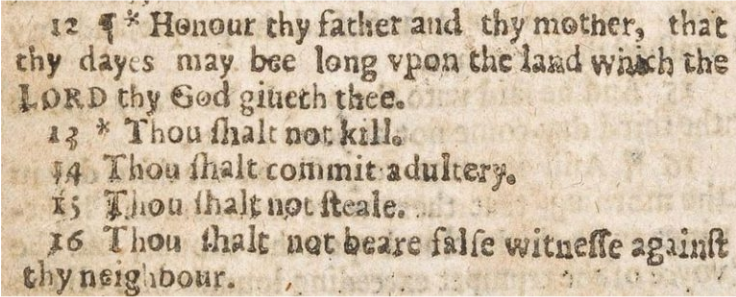
In Paris, the Imprimerie Royale du Louvre is established in 1640 at the instigation of Richelieu The first book that is published is ‘De Imitatione Christi’ (The Imitation of Christ), a widely read Catholic Christian spiritual book that was first published in Latin around 1418.
In 1642 Ludwig von Siegen invents mezzotint, a technique to reproduce halftones by roughening a copper plate with thousands of little dots made by a metal tool with small teeth, called a ‘rocker’. The tiny pits in the plate hold the ink when the face of the plate is wiped clean
The first American paper mill is established in 1690.
Eighteenth century
In 1710 the German painter and engraver Jakob Christof Le Blon produces the first engraving in several colors. He uses the mezzotint method to engrave three metal plates. Each plate is inked with a different color, using red, yellow, and blue. Later on, he adds a fourth plate, bearing black lines. This technique helped form the foundation for modern color printing. Le Bon’s work is based on Newton’s theory, published in 1702, which states that all colors in the spectrum are composed Of the three primary colors blue, yellow, and red
William Caslon is an English typographer whose foundry operates in London for over 200 years. His Caslon Roman Old Face is cut between 1716 and 1728. The letters are modeled on Dutch types but they are more delicate and not as monotonous. Caslon’s typefaces remain popular, digital versions are still available todav.

The Gentleman’s Magazine is published for the first time in 1731. It is generally considered to be the first general-interest magazine. The publication runs uninterrupted until 1922.
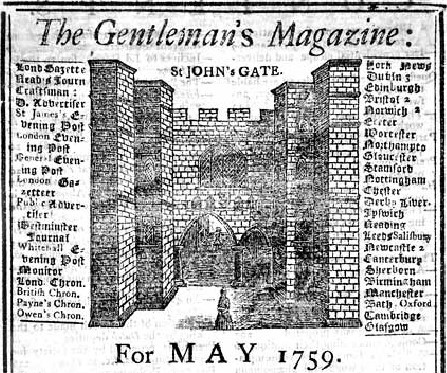
In 1732 Benjamin Franklin establishes his own printing office and becomes the publisher of the Pennsylvania Gazette. Among his publications, Poor Richard’s Almanac becomes the most famous.
The inventor of lithography
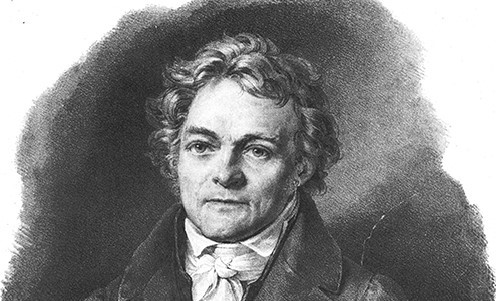
Johann Alois Senefelder was a German actor and playwright who invented the printing technique of lithography in the 1790s.
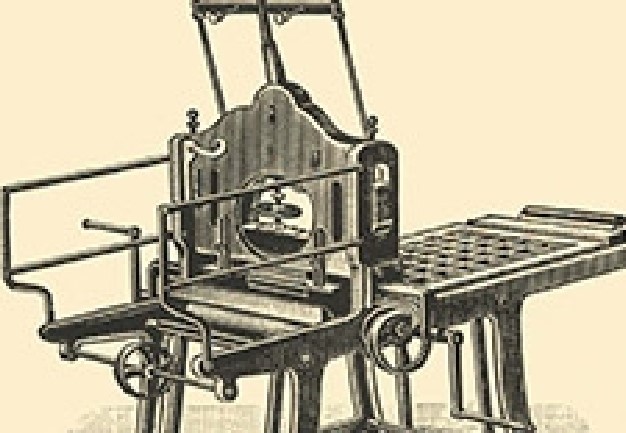
Problems with the printing of his play Mathilde von Altenstein caused him to fall into debt, and unable to afford to publish a new play he had written, Senefelder experimented with a novel etching technique using a greasy, acid resistant ink as a resist on a smooth fine-grained stone of Solnhofen limestone. He then discovered that this could be extended to allow printing from the flat surface of the stone alone, the first planographic process in printing. He called it “stone printing” or “chemical printing” , but the French name “lithography” became more widely adopted.
Another famous person from this era is Giambattista Bodoni who creates a series of typefaces that carry his name and that are still frequently used today. They are characterized by the sharp contrast between the thick vertical stems and thin horizontal hairlines.

Nineteenth century
In 1800 Charles Stanhope, the third Earl Stanhope, builds the first press which has an iron frame instead of a wooden one. This Stanhope press is faster, more durable and it can print larger sheets. A few years later another performance improvement is achieved by Friedrich Gottlob Koenig and Andreas Friedrich Bauer who build their first cylinder press. Their company is still in existence today and is known as KBA.
In 1837 Godefroy Engelmann is awarded a patent on chromolithography, a method for printing in color using lithography. Chromolithographs or chromos are mainly used to reproduce paintings. The advertisement below is from the end of the century and shows what can be achieved using this color printing technique. Another popular technique is the photochrom process, which is mainly used to print postcards of landscapes.
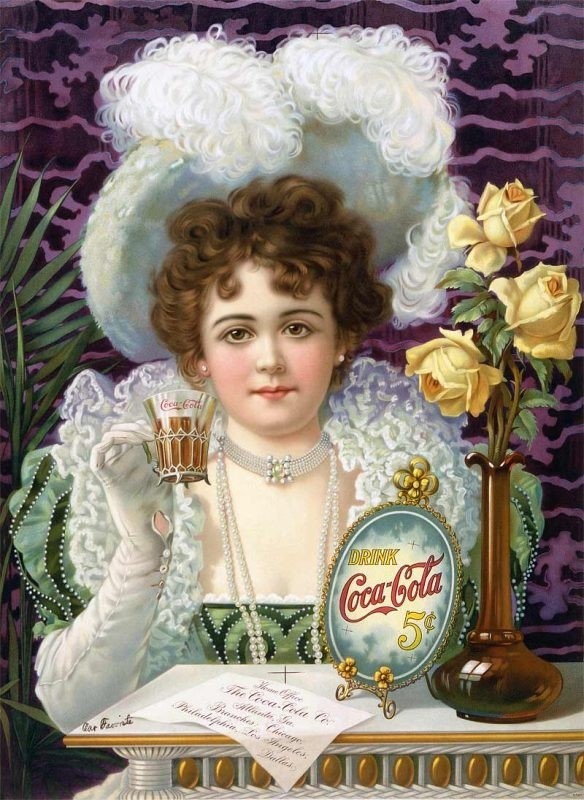
The Illustrated London News is the world’s first illustrated weekly newspaper. It costs five pence in 1842. A year later Sir Henry Cole commissions the English painter John Callcott Horsley to do the artwork of (arguably) the first commercial Christmas card. Around 1000 cards are printed and hand-colored. Ten of these are still in existence today.’
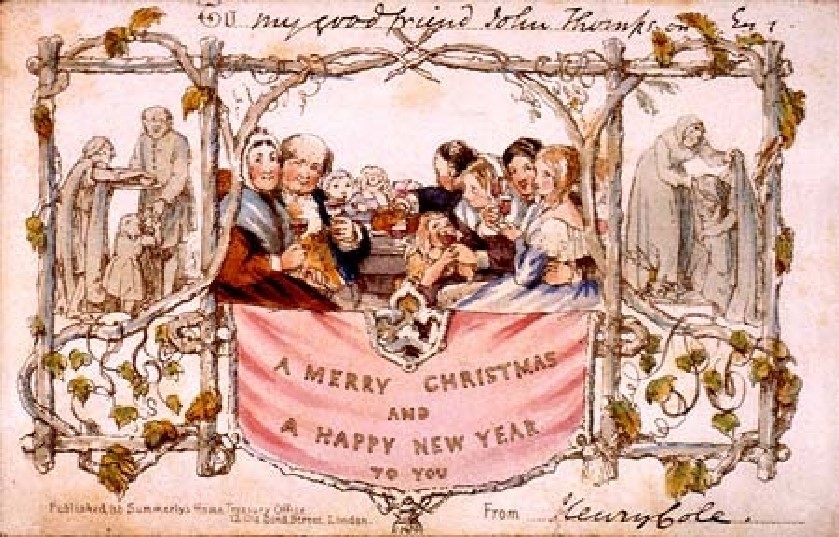
Around the same time, the American inventor Richard March Hoe builds the first lithographic rotary printing press, a press in which the type is placed on a revolving cylinder instead of a flatbed. This speeds up the printing process considerably.
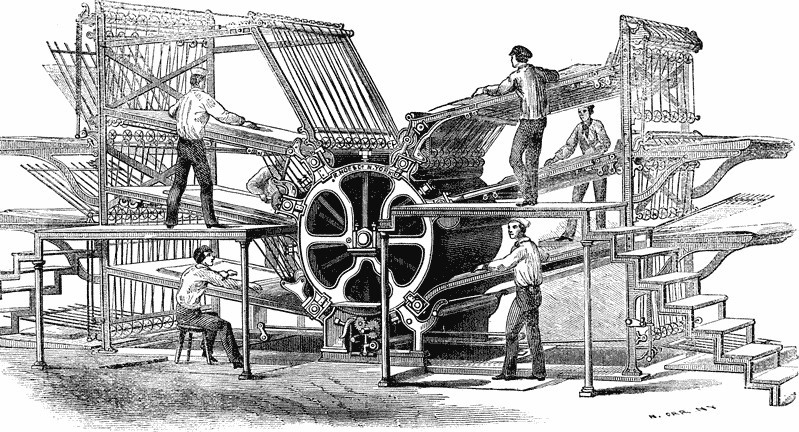
The Czech painter Karel Klíë invents photogravure in 1878. This process can be used to faithfully reproduce the detail and continuous tones of photographs.
In typesetting, Ottmar Mergenthaler’s 1886 invention of the Linotype composing machine is a major step forward. With this typesetter, an operator can enter text using a 90-character keyboard. The machine outputs the text as slugs, which are lines of metal type.
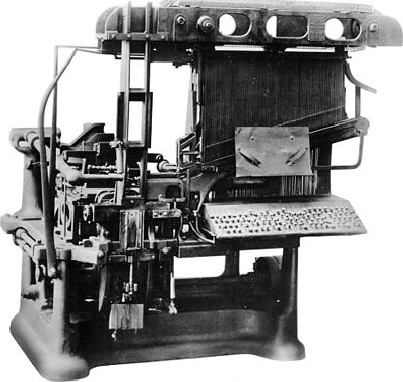
Lothar Meggendorfer’s International Circus is a nice example of the quality that could be achieved in those days. This pop-up book contains six pop-up scenes of circus acts, including acrobats, clowns, and daredevil riders
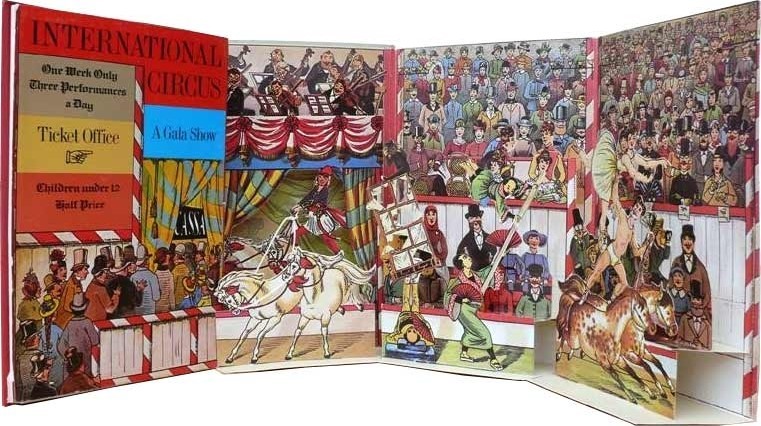
In 1890 Bibby, Baron and Sons build the first flexographic press. This type of press uses the relief on a rubber printing plate to hold the image that needs to be printed. Because the ink that is used in that first flexo press smears easily, the device becomes known as Bibby’s Folly.
Twentieth century
In 1903 American printer Ira Washington Rubel is instrumental in producing the first lithographic offset press for paper. In offset presses, a rubber roller transfers the image from a printing plate or stone to the substrate. Such an offset cylinder was already in use for printing on metals, such as tin.
In 1907 the Englishman Samuel Simon is awarded a patent for the process of using silk fabric as a printing screen. Screen printing quickly becomes popular for producing expensive wallpaper and printing on fabrics such as linen and silk. Screen printing had first appeared in China during the Shang Dynasty (960—1279 AD).
A few of the new press manufacturers that appear on the market are Roland (nowadays known as Man Roland) in 1911 and Komori Machine Works in 1923.
In 1915 Hallmark, founded in 191 0, creates its first Christmas card. It is during this same era that magazines such as the National Geographic Magazine (1888), Life (1883, but focussing on photojournalism from 1936), Time (1923), Vogue (1892) and The Reader’s Digest (1920) starting reaching millions of readers.
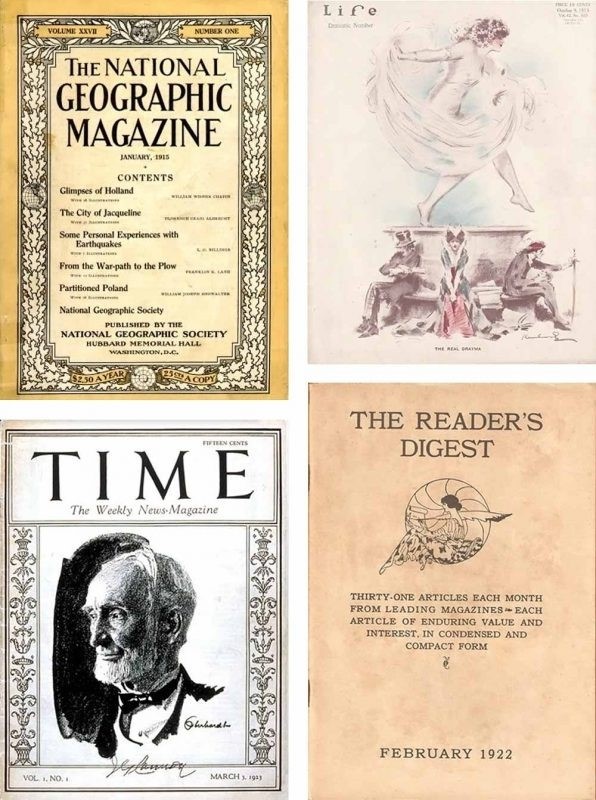
Press manufacturer Koenig & Bauer launch the four-color Iris printing press in 1923. It can be used for printing banknotes. Over time security printing becomes one of the main focus points of the company.
The first commercially successful series of paperback books are published by Penguin Books in the UK in 1935. Earlier in 1931 German publisher Albatross Books had already tried to market a series of lower-priced books with a paper cover and glue binding. Penguin copied many of the concepts of their failed attempt, such as the use of color-coded covers.

In 1938 Xerography, a dry photocopying technique is invented by Chester Carlson. The first commercial xerographic copier is introduced in 1949 but it is the 1959 Xerox 914 plain paper copier that is the breakthrough
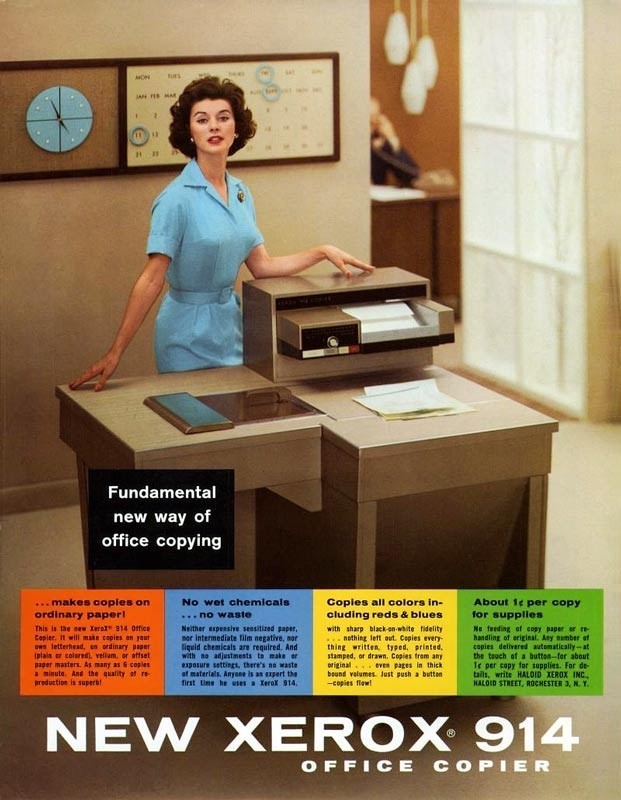
Japanese machine tool manufacturer Shinohara Machinery Company begins manufacturing flatbed letterpress machines in 1948. A popular press from that time is the Heidelberg Tiegel. The picture below shows it being demonstrated to German finance minister Ludwig Erhard at the first drupa trade show in 1951.

In 1967 the ISBN or International Standard Book Number started. This is a unique numeric identifier for commercial books. That same year Océ enters the office printing market with an electro-photographic process for copying documents using a special chemically-treated type of paper.
New materials like silicone make it possible for manufacturers such as Tampoprint to build more efficient presses for printing on curved surfaces. Pad printing can now be done on an industrial scale.
In the USA newspaper circulation reaches its highest level ever in 1973. It will remain fairly steady until a gradual decline sets in during the mid-’80s.
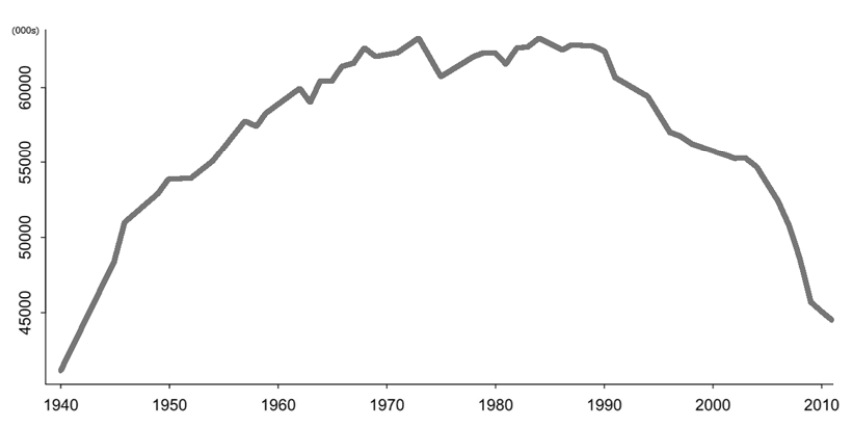
The first laser printers, such as the IBM 3800 and Xerox 9700, hit the market in 1975. They are prohibitively expensive but useful for applications such as cheque printing.

Desktop pub ishing takes off in 1985. The combination of the Apple Macintosh computer, printers and imagesetters powered by Adobe PostScript and the layout application Aldus PageMaker makes publishing more affordable
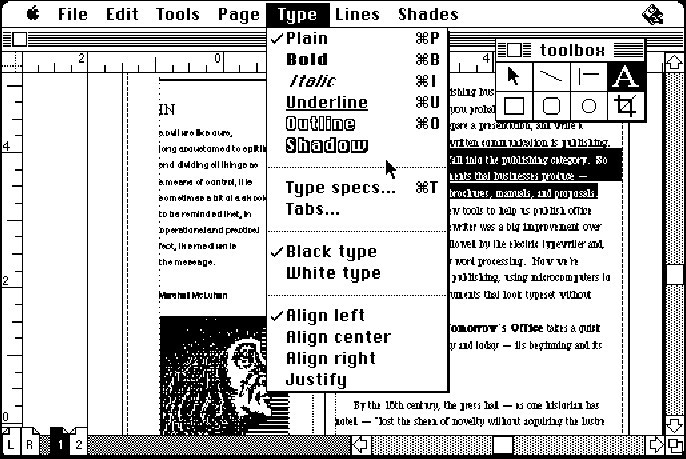
At drupa 1986 MAN Roland Druckmaschinen AG introduces its LITHOMAN commercial web offset printing press. Polar shows off the POLAR Compucut, a system for computer-assisted, external generation of cutting programs with automatic transfer to the cutting machine.
The Xerox Docutech, launched in 1990, combines a 135 page-per-minute black & white xerographic print engine with a scanner and finisher modules. It is arguably the first affordable print-on-demand publishing system
In 1992 Australia is the first country to use polymer banknotes for general circulation.
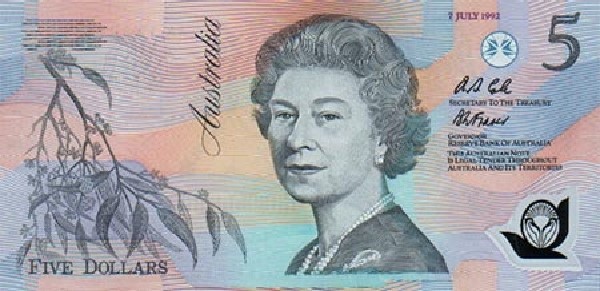
Digital printing takes Off in 1993 with the introduction Of the Indigo E-Print 100 (shown below) and Xeikon DCP- 1
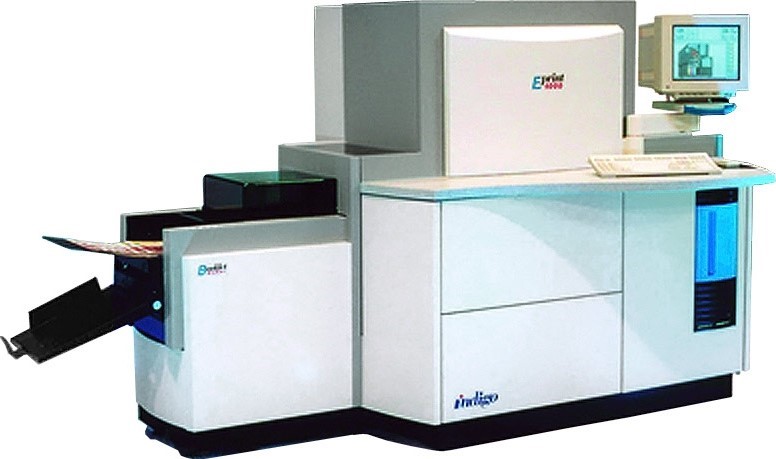
Twenty-first century
Offset presses still evolve incrementally. Two prime examples are the introduction of the KBA Cortina, a waterless web press for newspapers and semi-commercials, in 2000, and that of the giant Goss Sunday 5000, the world’s first 96-page web press, in 2009.
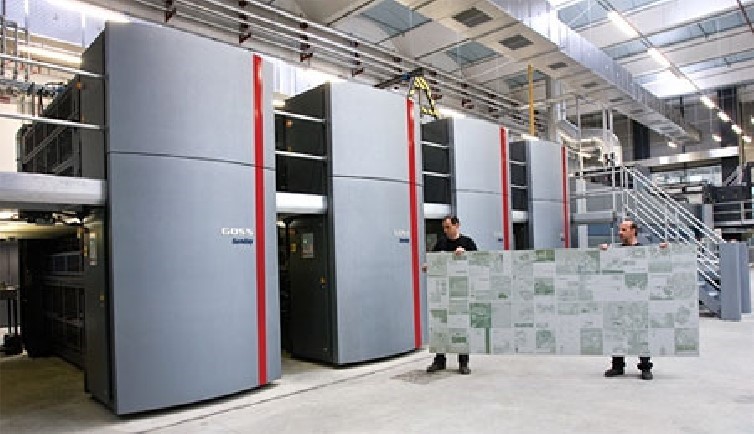
Bigger changes happen in digital printing with machines that evolve as fast as the companies that produce them. Take the NexPress for example. It is initially a joint development from Heidelberg and Kodak, later taken over completely by Kodak.
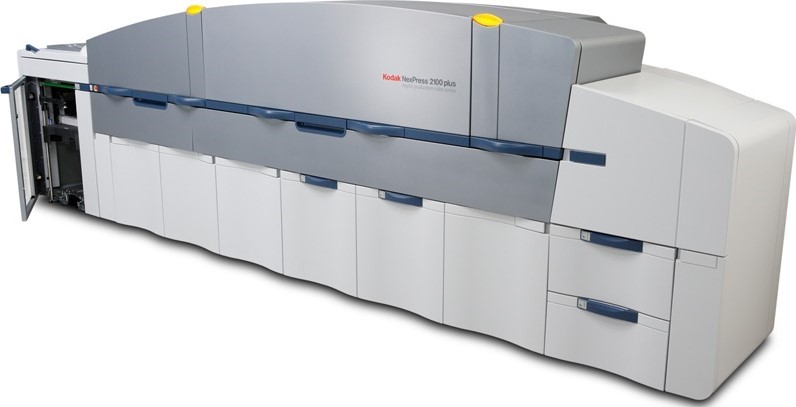
One of the bigger players in the market is HP, especially after its acquisition of Indigo in 2001. Other big players in the market are Konica Minolta with the Bizhub digital presses and Canon with its Imagepress range. Part of Canon’s growth is through its acquisition of Océ in 2009.
One area of the market that evolves quickly is that of large format inkjet presses for the sign & display market. Inkjet technology also starts making inroads in the packaging industry. At the 2016 edition of drupa the EFI Nozomi C 18000, HP PageWide (3500, and Durst Rho 130 SPC (shown below) are all presses optimized for printing on corrugated packaging board.
